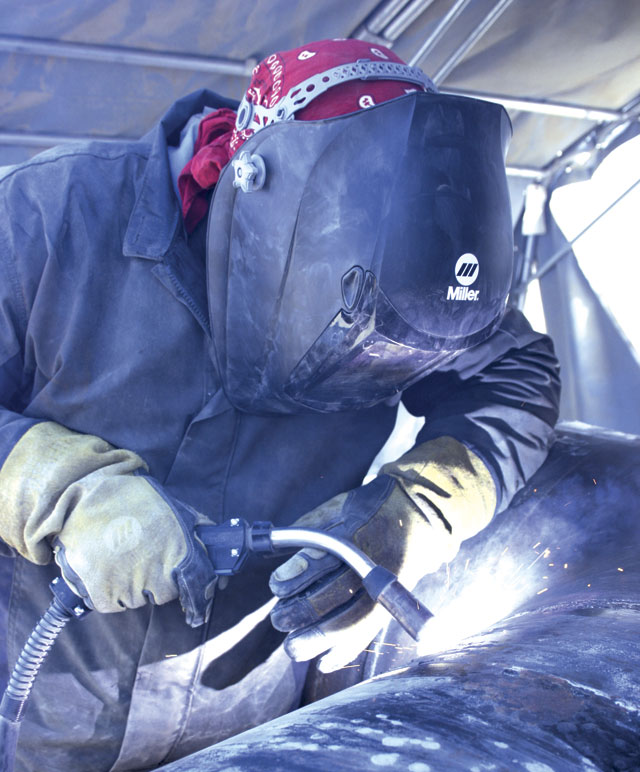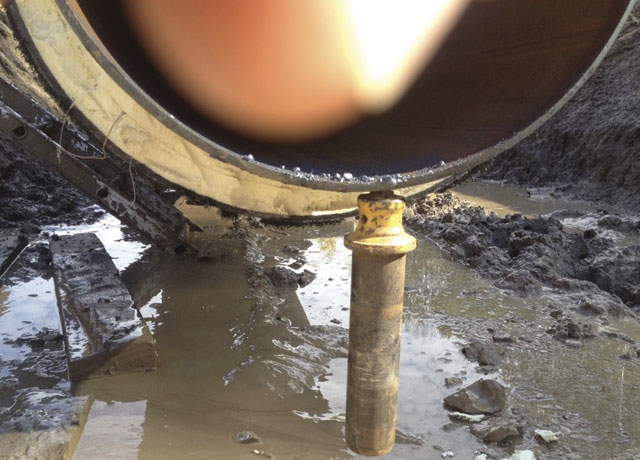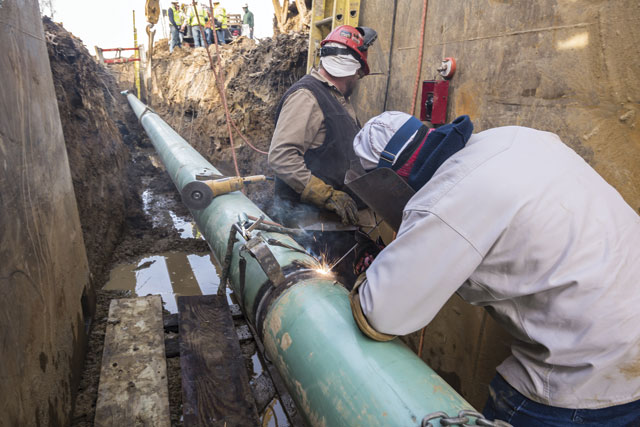by Nestor Gula
There are many factors that can lead to weld defects in pipe welds
For the past several years pipelines have been in the news. Industry wants to put pipelines in to move oil and gas from their extraction sites to the consumers and protesters generally want the pipelines to be safe and the environment respected.
While a chain is only as strong as the weakest link, a pipeline’s strength is defined by the quality of the welds. There can be no weld defects in any pipeline.
“Improper welding techniques and improper machine settings are two common causes of weld defects in tube and pipe welding. For example, it’s common for welding operators to set incorrect wire feed speeds, voltages and arc length settings when using GMAW, FCAW, GMAW-P and Regulated Metal Deposition (RMD) welding processes,” says Craig Spindler, CWI/CWE, welding sales specialist for Miller Electric Mfg. Co. “Defects are typically the result of poor cleaning of base or weld material, incorrect choice of filler metal or bad filler materials, wrong gas choice, improper technique or settings, and/or operator error.”
Pre-weld beveling and cleaning is crucial in pipeline welding as is fit-up. “You have to take time to actually fit the pipe,” says Brian Szenasi, the Alberta district manager for Lincoln Electric. “The pipe is never perfectly round, so quite often if you’re fitting one pipe to another pipe sometimes you have to rotate the pipe a little bit to try to get it so you minimize the highs and lows of the pipe. So, taking the time to try and ensure the best joint prep and setup as possible is the first thing.”
 Pipes can still be within tolerance, either in wall thickness, size and roundness but can then not match up well end to end.
Pipes can still be within tolerance, either in wall thickness, size and roundness but can then not match up well end to end.
“If you get, for example on the diameter, the plus side on one pipe and minus side in the other pipe then they don’t align, but they’re both within tolerance and that’s one factor,” says Alex Palynchuk, founder of Western Instruments and original inventor and patent holder of the Corod System (Coiled Sucker Rod) used in the artificial lift of oil. “When they double the pipe, you get a bevel and then on toward the inside of the pipe there’s a flat area, so there’s a tolerance there that you get; plus in one pipe and minus on the other pipe. Then there’s a misalignment there and it makes it more difficult for the welder to make a good weld. That’s what I refer to as geometric misalignment.”
Besides this geometric misalignment with pipes, the material of the pipe itself must be of the highest quality. “Occasionally there are issues with the material, but generally with the pipe manufacturers, that’s not an issue these days,” says Ken Thorn, a global welding engineer who recently retired from the Canadian Welding Bureau (CWB) Group. “The material of the pipe is what it says it is and what you expect it to be and the welding consumables are in good shape as well. There has been in the past some question about pipe quality, but I think if you’re buying North American pipe or if you’re buying good quality pipe, that’s not an issue. Certainly, anybody doing natural gas and oil pipelining is conscious of that. I mean, leaks and failures are big news these days and everybody’s trying to avoid them.”
 For most, if not all welding jobs, there are certain and specific welding procedures in place. Not following these procedures is a certain way to introduce faults into welds, which will lead to defects in the pipeline. You’re going to have these procedures whatever welding process you’re going to use –manual stick welding (SMAW) or an automated MIG welding system (GMAW). Following the parameters is essential.
For most, if not all welding jobs, there are certain and specific welding procedures in place. Not following these procedures is a certain way to introduce faults into welds, which will lead to defects in the pipeline. You’re going to have these procedures whatever welding process you’re going to use –manual stick welding (SMAW) or an automated MIG welding system (GMAW). Following the parameters is essential.
Even in the era of automation, operator skill is paramount for successful welds. “Stick is something that has been done for a long time and we have a lot of people, certainly in Alberta, with massive skills, with consistent quality, but every time you have a start and stop you have potential for a defect,” says Thorn. “So, with stick welding you’re going to have more stop and starts than with a wire process typically. Every time you have a start and stop you have to grind that stop to make sure you feather out the edge so you don’t get a fusion defect when you light up the new stick.”
The magnetic property of metal is a concern when welding pipe. “It makes it even more difficult depending in part on the degree or level of residual magnetism,” says Palynchuk, “When that happens it affects the stability of the arc and the arc can wander and be deflected and the welder has a difficult time getting the electrode and the arcing action and you can make a good weld.” The effect when the electric arc strikes magnetized metal is called arc blow. “Instead of going straight down to where you want to deposit the metal, the arc wanders all over the place.”
The level of residual magnetism varies quite widely in different metals and pipes.
“A pipe manufacturer is allowed to have residual magnetism in the pipe up to 35 gauss,” adds Palynchuk (a Gauss is a unit of measurement of magnetic flux density). “Then the pipe is hauled either by rail or by truck and in so doing they pass along under power lines which can affect the residual magnetism and can generate where you don’t have a very low level or residual magnetism and it can raise it very substantially.” He argues that because a pipe can be magnetized when it is transported to the field, “the only practical way is to demagnetize it when the pipe is on the right of way.”
Demagnetizing pipe is the only way to prevent arc blow and weld faults. Similar to how ships in World War Two degaussed themselves to be protected from magnetic mines and magnetic torpedo heads, the systems use coils of wire to neutralize the magnetic effect.
“We put the coil just over the end of the pipe, both sides, six inches,” says Palynchuk. “You reduce the level of magnetization and reverse the polarity and then you do that and then you step down and you can get the residual magnetism down close to the earth’s magnetic field which in this area is about one half a gauss.”
The main reason to ensure proper welding of pipelines is to make sure the oil or gas does not leak into the environment. Fixing a bad weld is an expensive and time consuming process.
 “Welding operators themselves don’t typically test for defects, except perhaps to grind the weld starts and stops and any minor defects,” explains Spindler. “Many fabrication shops have an NDT company test for weld defects, using either ultrasound or x-ray testing. One new technology is phased array advanced ultrasonic testing, which is a very fast, very accurate way to detect any type of defect in the weld material.”
“Welding operators themselves don’t typically test for defects, except perhaps to grind the weld starts and stops and any minor defects,” explains Spindler. “Many fabrication shops have an NDT company test for weld defects, using either ultrasound or x-ray testing. One new technology is phased array advanced ultrasonic testing, which is a very fast, very accurate way to detect any type of defect in the weld material.”
The type of testing one does is dependent on what type of welding process is used.
“If you’re doing shielded metal arc welding, then you’re probably going to use radiography as your test method because it will find slag inclusions in porosity and the type of slags that you are likely to fault, that you’re likely to have with stick electrodes,” says Thorn. “If you’re doing gas metal arc welding, you’ll probably want to use ultrasonic rather than the radiography because the types of faults that are likely to occur with gas metal arc are not going to be readily detectible with radiography.”
Depending on the standard of the code involved in the job and depending on the fault, some faults you’re allowed to repair while for others will involve an expensive and time consuming cut out repair.
“It’s generally the standard for pipelines that don’t allow for repairs,” says Thorn. Where one is allowed to repair a faulty weld, “you cut it out typically with a grinder, adds Szenasi. “So, if you’re doing ultrasound or X-ray they’ll tell you that at two o’clock (on the pipe) you have a defect that is X size and they’ll tell you whether it’s a lack of fusion or whether it looks like it is a slag entrapment. So you know where on that pipe the defect is, you take a grinder and grind it out and re-weld it.” SMT
